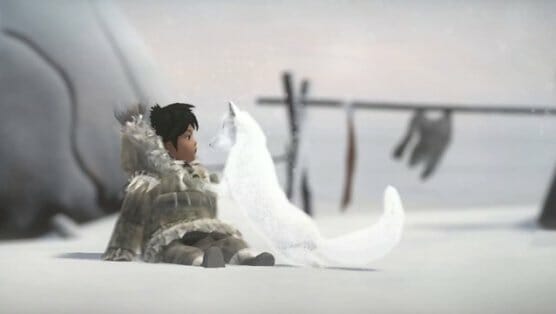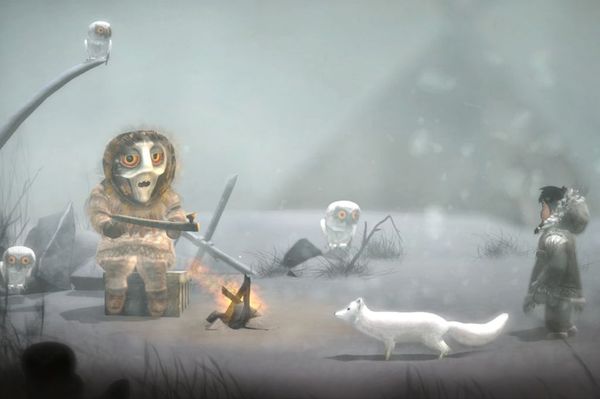
Modern geeks love to toss around the word “myth” for any story that involves more than two people that takes more than a minute to explain. You hear it most often and most embarrassingly in reference to comics, which definitely are rooted in myth, but you can take a cursory glance at DC’s New 52 and realize we’re not even in mythology’s zip code anymore.
Thing is, we have had the tools to truly propagate myth for some time now, and while sheer flights of fantasy enlighten, they aren’t the same. They aren’t the collective knowledge and experience of a people if what your story is and how you tell it is being decided by a small committee.
Never Alone is now a beautiful reminder of the difference. More than just another charming indie platformer, it IS, in fact, a collective effort by the Iñupiat people to bring their oral tradition into a new medium, where no such story has ever been told. The soul of a people, their morals, their values reinforced, retold, and strengthened by the telling itself, now given power and life by its very interactivity. It is, as the best myths are, a means of using fantasy to explore reality. And it is BEAUTIFUL.
Narrated by an actual Iñupiat elder, Never Alone is the story of Nuna, a young Iñupiat girl whose tiny village is on the brink of starvation thanks to a terrible blizzard. With nothing more than her warm clothes, and the unerring friendship of an arctic fox, she takes a journey to find the source of the blizzard.
It’s a deceptively simple story, and yet the stakes are high and tangible every step of the way. At the beginning, it takes all tiny Nuna has to even stay standing in the face of a cruel, unforgiving wind. When it’s not the wind, it’s nature itself: A polar bear, likely trying its best to survive the storm as well, chases her for what seems like ages. The ice under her feet can break at any given moment. The terrain itself is treacherous, uneven, seemingly working with the wind to daunt any who traverse. And when it’s not them, it’s a hideous abomination of an antagonist called the Manslayer, who has been leaving villages in ruins searching for treasures.
In Nuna’s corner, however, are the elders, the spirits of the frozen land, the animals, the northern lights, the things of legend that should be heeded if she is to survive the journey. Her fox companion can speak to the spirits, exaggerated caricatures of their nature that fade into existence to bring Nuna to where she must travel.
Stripped down to its barest elements, Never Alone is another in a line of platformers falling in lockstep with Limbo, of a small child running, jumping, climbing and solving puzzles in an overwhelming, immense world. But there’s a beauty here that Limbo, by its very nature, could never touch. If there’s a leitmotif to the whole game, it’s seeing the hidden grace in everything. There’s a tangibility and believability to this world even when at its most magical. We see the Iñupiat world through gentle, ethereal light, casting the pale, violet sun as otherworldly and familiar all at once. The trees are old, ancient, but creak and move and writhe in a way that commands fascination rather than fear. Even the polar bear that menaces Nuna throughout gives an impression of a creature that simply needs his next meal, afraid for his life. It’s a view of the harshest place on Earth from the eyes of those who live in respectful awe of it.
At first, that harshness is all a product of the environment, problems of shifting winds, cracking ice platforms, and the constant danger of falling into sub-zero waters from great heights. What makes you successful is an inherent trust in the environment to provide every solution, where the same wind blowing against you will become your vital ally, pushing your jumps further along. Whether an intentional, spiritual choice or not, you are at your strongest when you are in perfect balance with what the Earth is telling you, and getting in sync with its rhythm makes the first two thirds of the game a simple, but gratifying, thing. Whatever the Earth does not naturally provide, the supernatural will, in the form of your fox companion. He can be controlled by a second player and makes your life easier by climbing walls and awakening invisible spirits to provide new platforms or transport. You can switch between the two at the push of a button to solve the problems yourself as a single player, too. It’s reminiscent of last year’s Brothers: A Tale of Two Sons in its approach to making a single player co-op experience, and it creates the same instant sense of camaraderie between the two playable characters that game did.
The final third of the game spontaneously decides to dig the spurs in, however, and the difficulty spike takes away a tiny bit of the immersion and makes it more of a straight up challenge. It’s not a game without merit at that point. A new mechanic presents itself here, invoking the more pleasant, exploratory aspects of Child of Light, but after its introduction, it’s much trickier, and also a lot buggier, with multiple instances of switching to your fox companion leading to a computer-controlled Nuna to spontaneously leap to her doom, or falling through walls, or not being able to grab onto ledges for some reason. What is, ostensibly, the final boss makes a strong case for this being the price of ambition and scale, but the rest of this stretch has few excuses. (The developers are preparing a patch to ease some of the issues caused by this difficulty and the AI problems.)
And yet, by that point, it almost doesn’t matter, in the face of why you’re compelled to continue. The narrative supersedes all even through the worst the game has to offer. The story needs closure, the narrator’s wizened voice must run its course, its knowledge passed on to younger ears from an ancient voice, and a new medium. What was once carved into living rock is now a gigabyte on the Playstation Network. And even if the narrative failed to usher the player along, the Cultural Insights videos included in the game would do so as well, a real-life look at the indigenous people, the culture, and the folklore that inspired the tale, context that drives you further to want to see the world they live in survive and thrive. It’s a world you feel honor bound to fight for, and the game submerges you in their lives like no game does.
Ultimately, Never Alone’s very existence just proves how universal all of this really is. Even with this civilization that never gets this kind of attention and consideration from the outside world, their values, their heroes, their ideals are human, not cultural. The environment may be alien, but the smallest of us summoning the bravery and wisdom to dance with and around nature never stops being humanity’s most inspiring, timeless narrative. The myth behind Never Alone shows a completely alien tongue and a burgeoning medium speaking the same language as everyone on Earth: A language of hope and courage. There’s nothing like discovering for yourself just how close that makes all of us.
Never Alone was developed by Upper One Games and E-Line Media and published by E-Line Media. Our review is based on the Playstation 4 version. It is also available for the PC and Xbox One.
Justin Clark is a freelance games writer living and freezing in Rochester, New York. Formerly at CHUD.com, his work can currently be found at Slant Magazine, Gamespot, and Joystiq, as well as his own blog, Welcome To Class Real. He can be found on Twitter at @justinofclark.
